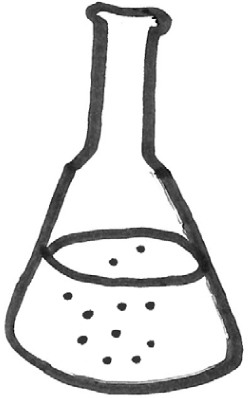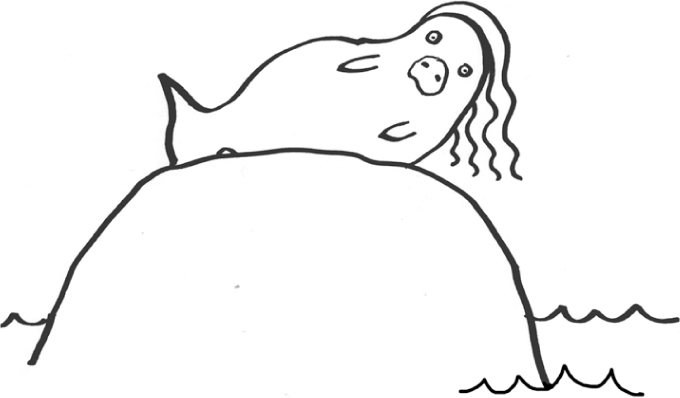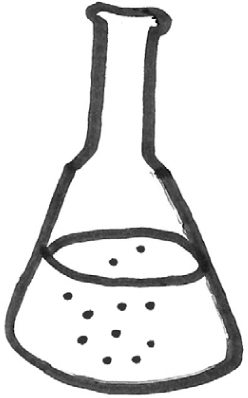CHAPTER 8
REAL MAGIC

 Magic Returns to the World
Magic Returns to the World 
At the beginning of our story, after a long absence, magic is returning to the Seven Kingdoms. We see the signs everywhere–the mysterious burning glass candles, the hatching dragons, the sawing women in half. (Oh wait, actually no–that wasn’t magic, that was Joffrey).
While we ourselves may still be waiting for such enchantment to return to our own humdrum world, there was a time in Western Europe, during the Middle Ages, when something very like actual magic began to zhuzh up people’s lives.
Historian Professor Owen Davies tells me about the new ‘magical’ knowledge that began to change Europe during this period.
After long years of warfare, the Black Death pandemic and raids by everyone from Vikings to Visigoths, many of the ideas, technologies and literary works that had stirred civilisation during the Roman period were lost in Europe. The sophistication of the Romans had built on that of the Greeks before them in the fields of geometry, astronomy, architecture, philosophy and more, but now in Europe those ideas were in ruins. The books that contained them had been lost or destroyed, bar a few pages copied out that turned up here and there, and even the memory of the knowledge was half-forgotten.
But then, new people and new ideas began to arrive. In 1453, Constantinopole (now Istanbul) was the last bastion of the Roman Empire, but under the command of 21-year-old Sultan Mehmed II (known as Mehmed the Conqueror) it fell to the Turkish Ottoman forces. Scholars and philosophers who had lived in the city fled–many to Italy. And when they arrived in Italy they brought with them many texts and works that hadn’t been seen for hundreds of years.
Ancient texts treasured and pored over were available again, for those who dreamed of discovering the fountain of eternal youth, and how to turn base metals into gold, and how to cast spells using Babylonian Love Magic.
The books being rediscovered contained useful facts but they also contained wonderful fictions. What was and what wasn’t true–could it all be?
In southern Spain, the Moorish civilisation flourished. And Muslim scholars–who had been the main custodians of Greek philosophy–were another conduit through which more knowledge flowed back into Western Europe. Knowledge of how to do anything and everything, from organising libraries to cultivating fruit trees, reappeared in the world. And the effect was extraordinary. It was like travelling back in time to someone doing their homework in the early 1990s and showing them today’s Wikipedia.
Jewish, Islamic and Christian thinkers influenced and were influenced by each other during this period, which seems to have enriched each of the religious traditions. But in addition to religiously sanctioned ideas, the classical works that arrived back in Europe also included works on magic itself. The Greeks had been very interested in this, taking ideas from the Babylonians. Religion and magic, magic and science began to cross-pollinate…
 Divided by Magic
Divided by Magic 
Westeros is divided in many ways, but one of the more subtle and interesting divisions relates to magic. Some of the characters have long been practising it whilst others fear and wish to destroy it. Some scoff at magic, believing it to be nonsense, others are convinced that it is living, burning and freezing in the realms of ice and fire. And as readers and viewers, we tend to agree with them. What we see feels like real magic.
In one corner, we have dragons and White Walkers and (presumably) all the fantastical beasts, like ‘grumpkins and snarks’, that Tyrion describes. In the opposite corner, there are the Maesters, those scientists, historians and postmasters who advise the Westerosi nobility, and hate dragons like there’s no tomorrow (which of course there probably won’t be, if the White Walkers get their way).
Of course, the magic in Game of Thrones is not about pulling rabbits out of top hats, making coins appear behind ears or guessing the right card. Instead, it is unpredictable and those who use it are not necessarily shielded from its consequences. For instance, Jon Snow asks the wildlings, if they have a magic horn that can bring down the wall, why don’t they just use it? The wildlings’ reply is as instructive as it is chilling: there’s no easy safe way to use magic. They say it’s like having a sword with no hilt–how can it be safely grasped?
Not everyone is a fan of magic. In the Seven Kingdoms the stakes are too high, with one person’s life saved at the cost of another person’s death.
Lord Varys the eunuch, for example, clearly hates the stuff. He tells Tyrion Lannister the horrific story of how as a young boy he was castrated by a sorcerer and watched his genitals burn in a blood magic ritual. (By a strange coincidence, in our world, magician Paul Daniels suggested something similar with the Head of Light Entertainment when the BBC cancelled his Saturday night show.) Having served his purpose, Varys was then thrown out into the street to bleed to death.

Still angry, still troubled, Varys reveals that he still dreams of that night and the voice that came from the flames as his flesh burned. What was it? A god, a demon or simply a ventriloquist? While the eunuch recounts his tale, he unwraps a large box. And as he reaches the bitter end, we discover that, after all these years, he has tracked down the responsible magician who is now powerlessly trapped inside the box, like a spider under a glass. It’s a dramatic reveal, darkly reminiscent of David Blaine’s London perspex-crate-based stunt beside the Thames, but with a smaller if equally belligerent audience.
Varys isn’t the only one you’d hesitate to bring along to watch David Copperfield. The Maesters are also rather down on supernatural happenings. On the night before they officially become Maesters, each of them must complete their training by spending a night trying to use various spells to light a long stick of obsidian referred to as a ‘glass candle’. Such candles are kept as novelties and associated with quaint stories about how they once burned with a strange, colourful light that enabled sorcerers to communicate half a world away. The trainee Maester’s tireless, but ultimately unsuccessful efforts are designed to demonstrate that magic is not real, that there are limits to what it is possible to know.
However, despite the deep-seated unease and scepticism, there is no stopping the rise of magic in the Seven Kingdoms. The glass candles are beginning to light up again, of their own accord, as magic slowly returns to the Known World.

 Giving the Gift of Death
Giving the Gift of Death 
(Keep the Receipt)
Many significant occasions in life are marked by an exchange of gifts, in both our world and the world of Game of Thrones. But it is often hard to find the appropriate gift for any occasion–marriage, festival, or the opening night of a friend’s play. The Faceless Men of the great city of Braavos have solved this dilemma. Not for them all of that worrying in Blooming-dale’s over which artisan home ice-cream maker looks the best and most expensive the afternoon before a big event. Nope! The Faceless Men always give the same gift, and it works for every occasion: the Gift of the Many Faced God. If that sounds spiritual-yet-practical, remember this is Game of Thrones– the Gift in question is… Death. (Durr–obviously…)
The Faceless Men–more correctly The Faceless Persons, as women can totally join–are a sort of assassin’s guild. They are hugely skilled at what they do, and can be hired at great cost to off a well-guarded enemy, or bring a swift, merciful end to the suffering of a dying loved-one.
But death is not a gift they go around giving to just anyone. Oh no! The Faceless Men get very angry indeed with Arya, who fights in anger and recites her kill list each night. In the books, The Faceless Men have in-depth discussions about how they cannot kill those they know. This attempt to rationalise killing, to rob it of all emotion, can appear odd to those of us who live in countries that don’t have the death penalty, or who personally oppose it. But it also seems to be a very human thing to do.
Arya sees the assassin’s company of Faceless Men sitting around the dinner table, planning who will kill who. Y’know, as you do. Some of them cannot kill the men or women they’ve been asked to kill because they recognise their names, and know them. Others agree to kill them instead because they don’t know them.
These scruples about killing someone you know extends to assassins in the real world as well. Take, for example, criminologist Saul Alinsky’s dissertation on Al Capone and his associates, in the 1930s. Alinsky spent time with the legendary gangster and his associates, and got a unique and detailed insight into their murderously criminal activities.
In an interview for Playboy, he remembered looking over the mobster’s records and spotting a large payment to an out-of-town killer. (Even gangsters can’t escape admin. Who knew?) When Alinsky asked why it was necessary to bring someone in to kill, when there were 20 killers on the payroll, he was told that this was because some of the targets may be known to them–apparently, the mobster contact seemed genuinely shocked at his callousness in asking such a dumb question.
Arya Stark runs away to join the Faceless Men to learn their assassinatin’ ways, fuelled by anger against those who have destroyed her family. Entirely reasonably, she wants to kill every single cruel and murderous individual who has messed with her family, and we cheer her on in this. What she isn’t expecting is to have to practise a sort of kindly euthanasia for those who are suffering.
A father brings his young girl to the House of Black and White so she can find release from her sickness which cannot be cured. Never a show to shy away from showing grim stuff happening to small children (Shireen!), we see Arya give the girl, not much younger than herself, a drink from the fountain in the centre of the temple of the Many Faced God. And the girl duly dies. This would be traumatic for some, but Arya, who, as we know, is probably an unfeeling psychopath by this stage, seems fine with it. And we love her anyway.
It is not clear whether the fountain is supernatural. But the powders and potions that Arya learns to mix in Braavos, whilst blind, must be learned by smell and touch, implying they contain ‘real’ chemicals.

In our world, the medicalisation of executions–and the production of a painless liquid poison–has been a controversial one. The drug of choice for death by lethal injection in the United States–sodium thiopental–was invented in 1934. It was controversial from the start. Used as an anaesthetic to treat the wounded after the Pearl Harbor attacks in the US, it was implicated in the deaths of some of those who were operated on–though subsequent research suggests the drug probably wasn’t to blame for the deaths. In small doses, it was used as the ‘truth serum’ you hear about in Hollywood movies of the 1940s and ’50s. All but one of the 35 US states that carry out executions used the drug in lethal injections. But in 2011 the supply dried up, as the sole American manufacturer of the drug announced it was ending production. And manufacturers in Europe already faced a ban on exporting the drug to the US, as capital punishment is not permitted within the European Union.
Faced with such obstacles, US death row states started using an untested drug, pentobarbital, in executions (the drug is licensed to treat the most stubborn forms of epilepsy). But in May 2016 the drug company Pfizer imposed sweeping restrictions on the distribution of all its products, to ensure that they couldn’t be used in lethal injections. And thus ‘all FDA approved manufacturers of any potential execution drug have now blocked their sale for this purpose’ according to a representative of the Human Rights Charity Reprieve (as reported in the New York Times).
The strain on the death row supply chain spells a decline in judicial killings in the US. According to the Death Penalty Information Center (it’s a thing), the scarcity of injection drugs has contributed to the number of scheduled executions dropping dramatically–98 were carried out in the US in 1999, as opposed to 28 in 2015.
 Snarks and Grumpkins
Snarks and Grumpkins 
and Fairies–Why We Want to Believe
When Jon Snow speaks of the role of the Night’s Watch in protecting the ‘civilised’ world, Tyrion Lannister interrupts him mockingly, suggesting that the only things out there, in the frozen North, are grumpkins and snarks. The White Walkers are simply another mythical monster that wet nurses frighten children with. The men who defend the Wall may think that all Seven Kingdoms are counting on them, but no sophisticated Westerosi believes in fairy tales.
Almost from the start, readers and viewers know that Tyrion is mistaken: the magic and myth surrounding the White Walkers is real: the ‘Others’ are a greater threat than the War of the Five Kings. But the entertainment comes from watching as belief and scepticism shape the world of Game of Thrones.

We know very little about snarks and grumpkins, but they seem to be a little like the fairies of our world, even down to grumpkins being able to grant three wishes. The mysterious Children of the Forest, the first inhabitants of Westeros, are close to the ‘fairy’ tradition in our world too. And it is they who created the White Walkers with magic that then went bad. George RR Martin compares the ‘Others’ to the Aos Sí, a supernatural race from Irish and Scottish mythology who live in ancestral burial mounds.
In our world there are many who believe in the existence of fairies, sprites, elves and other hidden people. Fairy tales were once something for everyone. The Grimm brothers collected stories to entertain adults. And storytellers around the world passed the long nights with their narratives of ‘Once upon a time…’ But throughout the 20th century, believers and sceptics argued over the effect of a belief in the supernatural.
The most famous case dividing the two sides is the Cottingley Fairies, a series of five photographs, apparently depicting two cousins interacting with fairies.
In 1917 the village of Cottingley in Yorkshire was home to two young girls, Elsie Wright (aged 16) and her cousin Frances Griffith (aged 9). The cousins would spend hours together playing by Cottingley stream and would come home to tell Elsie’s parents of the fairies they encountered there. Not being taken very seriously by their family, one day Elsie borrowed her father’s camera and later triumphantly returned having captured ‘proof’ of the fairies. Elsie and her keen amateur photographer dad developed the pictures from glass plate negatives in his darkroom. Elsie’s father still wasn’t convinced, but her mother was less doubtful and took the pictures along to a lecture she attended that touched on the subject of fairies. When experts and learned men saw the pictures, the story really began to take off, with the master of detective fiction, Sir Arthur Conan Doyle, writing about the fairies in a popular magazine’s Christmas issue.
Because of the nature of the early plates used to photograph the fairies, it wasn’t possible at the time to assess the images in great detail, in the way that photographs of apparently strange phenomena are routinely examined today. Nowadays we can ‘blow up’ images to study every minuscule portion of them, but 100 years ago, when confronted with fairy folk, it wasn’t as simple as just taking a really close look at the pixi[l]ies.
At Conan Doyle’s prompting, various photographic experts in the 1920s (including some from Kodak) vouched for the photos. They couldn’t go so far as to say they were genuinely capturing the images of fairies, but they did not see any obvious signs of being ‘faked’ (though they didn’t go so far as to say ‘it’s definitely true–fairies are real, everyone!’). Others poured scorn on the very idea that anyone could possibly believe in fairies at all, with or without photographic proof, so the controversy continued.
Doyle was famous for writing the deductive reasoning of Sherlock Holmes into existence, but his keen interest in the supernatural lost him good friends. Harry Houdini had previously fallen out with him over his friend’s fervent belief in séances. Still, his belief that the photographs were authentic was shared by many.
The photographs appeared at a time of great upheaval in Western Europe. They were taken in 1917 while World War I was being fought, and captured the public’s imagination when they were published in 1920, two years after the war ended. The 1920s saw a collective yearning for the lost sons and fathers and brothers and husbands who had violently perished in the fighting. When the girls’ photographs appeared, they offered up dancing fairies gathering flowers to a world that longed for the innocence of a numinous experience after so much bloodshed and horror.
But the end of the story is in its beginning. When first shown the photographs, Frances’s father teased her that she was messing about photographing ‘bits of paper’. American magician and arch-debunker of the supernatural James Randi returned to that idea in the late 1970s, identifying and widely publicising the similarity between the 1917 fairy photographs and some illustrations of dancing, elegantly draped figures that appeared in Princess Mary’s Gift Book, published a couple of years before the fairies first materialised. Here are the same dresses, the same poses–unmistakably copied from the book. It’s clear we are looking at little cut-out drawings.
As first reported in the New Scientist magazine in 1978, Randi believed he had detected ‘strings’ holding the paper fairies up by enhancing the images ‘using the latest technology’. However, these strings are probably no more real than the fairies themselves. As Elsie eventually admitted, the girls had cannily encouraged the well-drawn little folk to remain upright and spritely using hatpins. You can spot the point of one of said pins in the photo of Elsie and a small gnome. Conan Doyle noticed this ‘dot’ and, from its position on the gnome’s midsection, assumed it to be a belly button, thus indicating to his mind that fairies give birth to babies with umbilical cords, just like humans do. (Had the tip of that pin ended up elsewhere, who knows what other conclusions the creator of Sherlock Holmes would have drawn about the fairy anatomy?) But it seems we all sometimes see what we want to see–sceptic or believer.
Both women hinted at different times that they had seen something, or somehow photographed their ‘thoughts’, before Elsie finally admitted that the photos were a hoax. Frances, on the other hand, maintained that the fifth and final photo they took was genuine. It shows the fairies alone together in the grass; they appear to be semi-transparent, most likely caused by a double exposure.
Prompted by the photo that shows one of the fairies atop a mushroom, psychologist Professor Richard Wiseman discovered a botanical map of the Cottingley area that dates from Elsie and Frances’s time, showing the distribution of mushrooms in the area round the stream. Many of them were psilocybin, the type of mushroom containing the psychedelic compounds psilocybin and psilocin, which famously cause hallucinations.
Given that for obvious reasons the two women were reluctant to expose their hoax and each other, it’s unlikely that they would have made things even more weird by admitting to being off their faces on hallucinogens as children, and it’s also unlikely they would have been deliberately eating the mushrooms for this reason. But it does possibly offer an explanation of why both Elsie and Frances maintained until the last that even though the photos were faked, they really did see fairies down by the stream.

There’s a longstanding link in European folklore between fairies and mushrooms. Fairy rings–circles ranging in diameter from less than a metre to over 10m (33ft)–are still to be seen on open grassland and in woods. A fairy ring, also sometimes referred to as an ‘elf circle’ (but never as a ‘pixie hole’) is certainly a charming sight. Traditionally these circles are said to have been made by the little folk dancing in the round, but we now know in fact they’re caused by the presence of the fungus mycelium in or underneath the outlined arc. Around 60 different species of mushroom can grow in this ring pattern.
We see an echo of this link between magical folk and consuming hallucinogenic substances in the world of Game of Thrones, with the visions of Bran Stark. When Bran eventually finds his way to the caves where he meets his spiritual guide and teacher Bloodraven, as well as the fairy-like Children of the Forest, he is given a bowl of weirwood paste, made from the sap of the ancient trees, which when he eats it gives him visions of the past and future awakening his belief in his own abilities as a ‘greenseer’.
Whether or not Elsie and Frances were tripping on ’shrooms (let’s not judge) there’s something strange and beautiful, moving even, about the story of these clever mischievous young women who brought some magic into a world that so desperately wanted to believe in it.
In an interview in 1985, a few years before her death, the elderly Frances gave an interview to Arthur C. Clarke for his popular World of Strange Powers TV show. She explained that as a child she felt too embarrassed to tell the truth after the stories and photographs of fairies she and her cousin created captivated a ‘brilliant’ man like Conan Doyle. ‘I never even thought of it as being a fraud,’ she said. ‘It was just Elsie and I having a bit of fun and I can’t understand to this day why they were taken in. They wanted to be taken in.’
The spectacle of people thirsting for spiritual fulfilment and purity after the turmoil of warfare and violent loss is a cycle that repeats itself, time and time again. We see it happen in Westeros with the rise of the Faith Militant, the ‘extremist’ arm of the Faith of the Seven, the major Westerosi religion. The revival of spiritual fervour is a direct response to the terrible and destructive War of the Five Kings. Even in times of peace, environmental psychologists have found that a belief in the spiritual may prove advantageous. Research shows that, whilst secular folk live purposeful meaningful lives, those with religion or spirituality tend to feel their lives restored and protected through difficulties, by believing in supernatural forces beyond their control.
 What makes a believer?
What makes a believer? 
Or, the Sceptical Smiths
We know magic is a real force in the Seven Kingdoms, yet for all the characters who believe in the Red Witch Melisandre’s predictions, or the White Walkers, or the Children of the Forest, there are individuals in the world of Ice and Fire who are decidedly sceptical.
In our world, neuroscientists and psychologists have shown an abiding interest in studying why some of us believe in the supernatural while others scoff at it.
All kinds of intriguing theories as to why we accept an idea–mermaids exist!–while others scoff have been advanced.
It has long been known that believers in matters paranormal are prone to seeing patterns where none necessarily exist. Believers are especially likely, for instance, to see a non-existent ghost popping up behind granny Jane in their holiday photos, or to conclude that a dream bears an uncanny resemblance to the following day’s news headlines and is therefore ‘a sign’. Some scientists have taken a decidedly brain-based approach to explain this phenomenon, suggesting that this overly-enthusiastic approach to spotting patterns is due to having lots of dopamine (a neurotransmitter that carries signals between nerve cells) in the brain.
Support for this theory comes from a set of studies in which sceptical participants were given a drug that increased their dopamine levels, and promptly started seeing coincidences and non-existent patterns during several tests. Prior to the dopamine-boosting shot the sceptics missed spotting some of the words and faces the researchers briefly flashed up in front of them on a screen. After they’d received the shot, they became more likely to notice coincidences and patterns emerging, identifying even the scrambled faces and words as the real thing. Given that the level of dopamine swishing around in your brain is determined, in part, during your time in the womb, this theory suggests that some people are indeed born to believe.
To me, one of the most interesting theories that came out of the studies is that those who are likely to believe in supernatural events are less likely to be familiar with probability theory. You can see how this might work. Let’s imagine that you dream about winning some money and then wake up to a telephone call from your friend announcing that they have just hit the jackpot on the National Lottery. In reality, you dream almost every night of your life and so, just by chance, at some point some of these dreams will show some similarity to subsequent events. However, if you haven’t encountered this aspect of probability theory then you might be tempted to conclude that your dream predicted your friend’s lottery win. Of course, other aspects of psychology suggest whether you will conclude your claim to prophecy, with a reminder ‘about that fiver I lent you in 1994’. But I digress.
The ‘believers don’t really get probability’ is a nice theory, but is it true?
Let’s consider a test study.
Imagine you meet Mrs Smith in the street and you know she’s a mother of two (How? Perhaps she’s wearing a T-shirt saying ‘Mum of Two of the Year’). Anyway, then she introduces you to the youngster at her side. Let’s call him Shakespeare Smith.
‘This charming man is my son!’ she says, beaming proudly.
What are the chances her other child is a girl?’ When I first heard this problem I thought–easy–1/2! Obvious! But I was wrong. There are four possible scenarios re Mrs Smith’s two children.
1 Her first child is a girl and her second child is a girl.
2 Her first child is a girl and her second child is a boy.
3 Her first child is a boy and her second child is a girl.
4 Her first child is a boy and her second child is a boy.
We know that Mrs Smith has a son as he’s here in front of us, wearing his ‘Mrs Smith’s Son’ T-shirt (they’re a remarkably literal family, the Smiths), so 1 can’t be true. That leaves us with 2, 3 or 4 as possibilities. As two of these three possibilities give us ‘the other Smith child is a girl’ (let’s call her Sheila Smith) the chances are 2/3.
Immediate, real world applications for this could, for instance, be the next time you meet a very attractive but attached person, you can do a quick bit of working out the chances on the back of an envelope before asking, ‘Do you have a brother?’
This nice illustration of how probability theory shows how our intuition doesn’t always match up against the math. It is known as The Boy or Girl Paradox and was popularised in the 1950s by Martin Gardner, the much-loved mathematician, magician and Alice-in-Wonderland-aficionado.
These types of questions have been presented to believers and sceptics over the years and the results show that the ‘disbelievers’ tend to outperform the ‘believers’ time and again on tasks requiring statistical thinking or involving probability judgements. If you’ve never encountered probability theory you’re more likely to believe in a supernatural explanation, as we humans just like things to be explained somehow.
Presumably the reverse could also be true. If you’re brought up in a very rational environment, versed in statistics and numbers and measurements, and never really have much to do with thinking about the paranormal, you’re more likely to find rational explanations for why you’re having what seems like a particularly unlucky day. Let’s imagine you wake up, it’s raining, then on your way to work you’re splashed by a bus, then the heel falls off your shoe, and when you get to work your boss tells you you’re being made redundant. For a rational type, your reaction may well be to recall hearing that the municipal authorities in your area have recently cut back on spending on road maintenance, leading to more pond-like potholes when it rains (which it does a lot at this time of year), then ponder that your shoes were £4.99 in the sale–and maybe there was a reason for that?–before finally looking up the employment statistics for your job and realising the number of people earning a living in your profession has shrunk by 20% in the last decade. (You would probably never say to yourself ‘l bet a witch is behind all this’.)
Anyway if you got the answer right, congratulations. Take a bow. You are the rational type. If, like me, you managed to get the wrong answer then you are more intuitive, and therefore possibly more likely to believe in the paranormal. Saying that, if you do happen to dream about next week’s winning lottery numbers, drop me a line?
 Gene Genie…
Gene Genie… 
If we could get hold of some fresh, fertilised, fantastic dragon eggs in our world, would it really be possible to hatch them with science? In 2006, the Economist ran a story about Dr Paolo Fril, chief scientist at the Gene Duplication Corporation, who was running computer models with the expectation of one day creating a whole host of mythological beasts, including dragons, gryphons and unicorns. As you might expect, certain aspects of this process were proving tricky. But, as the Economist reported, ‘If he can get the dragons’ respiration correct, he thinks they will set the world on fire.’
Many researchers thought the idea was a touch unfeasible, but many more noted that the 1st April publication date was maybe a clue about the true nature of the article. However, fast forward a few years to the present day, and a new gene-editing technology called CRISPR-Cas9 has come along. And suddenly the world is full of intriguing possibilities.
CRISPR-Cas9 can be described as DNA scissors. It’s a gene-editing tool that allows scientists to snip out bits of the genome with molecular precision. These ‘holes’ can then be patched with another piece of genetic material, repairing or replacing what has just been cut out. In short, scientists now possess minuscule sewing kits that might, in skilled hands, one day be capable of tailoring the basic stuff of life into ever more fantastic designs.
While we wait for Professors Emmanuelle Charpentier and Jennifer Doudna to be awarded the Nobel Prize for Chemistry for developing CRISPR, today’s Biology undergraduates at universities around the world are already using it for ‘simple’ genome altering projects. And this is just the beginning. It’s hoped that the ability to ‘edit’ genes could be used for tremendous good in our world. For instance, we could alter the genes of the infected mosquito that carries malaria in its bite, rendering it harmless and thus wiping out a disease that kills around a million people each year (most of them young children). Viruses have a genome, and therefore in future we could perhaps use CRISPR to mutate HIV. A trial using patients’ own immune cells adapted with CRISPR to target and destroy their cancers has recently begun.

And once the gene-editing genie is out of the bottle, we can start having some serious fun. In 2015, two bioethicists, R Alta Charo of University of Wisconsin School of Medicine and Public Health and Henry T Greely, of the Stanford School of Medicine, published an essay about the possible role of CRISPR in making science fiction science fact.
They ask, ‘If you could wish into existence any animal, plant or microbe you wanted, what would you make?’ (I went for ‘a flock of tame golden hummingbirds’, then ‘Channing Tatum’.)
The bioethicists sensibly caution that CRISPR ‘will not repeal the laws of physics–no flying horses–and biology may just not permit some variations–perhaps no large animals with functioning wheels’. (Boring!) But given continued advances in genome editing technologies and our understanding of how DNA works, pretty much any animal that could be created, could, well, be created. Which means it’s only a matter of time before a billionaire decides to give his daughter a unicorn for her birthday, or someone has a go at designing… wait for it… a real dragon!
Exploring the premise further, the authors note that physics will almost certainly combine with biological constraints to prevent the creation of flying dragons or fire-breathing dragons (see Chapter One guys!), but a very large reptile that looks at least somewhat like the European or Asian dragon–perhaps with flappable if not flyable wings?–that could be possible some day they believe.
Because of the legal complexities involved in regulating the brave new frontier of genetic manipulation (the issues are considerable, complex, and likely to be thrashed out in laboratories and courts around the world for years to come), work in this area may not outlawed for quite some time. Which means that several Do-it-Yourself ‘biohackers’ are on the case, say Charo and Greely, ‘exploring possibilities such as changing blue flowers back to their original white, or producing the protein needed for vegan cheese, all in their own homes or informal community labs’. Tasty vegan cheese today, dragons tomorrow? Who knows?

George RR Martin’s fiction reveals his extensive interest in and knowledge of genetics. And Game of Thrones fans have learned to be a patient bunch. So, if the great man is taking a little while longer than expected finishing off the books, could it be that he’s busy with some DNA, and some very, very tiny scissors…?
 Mermaids
Mermaids 
The world of A Song of Ice and Fire is choc-o-bloc with weird and wonderful creatures, and whilst the majority of these are land-based, some make their home in the sea. Take, for instance, that half-fish, half-human classic, the mermaid. Mermaids or ‘merlings’ crop up in various guises throughout Game of Thrones. There’s a popular fan theory that Spymaster Varys is a merling–it would explain now he gets around the Seven Kingdoms so quickly. Most notably, The Grey King, ancestor of Theon and the Greyjoys, makes the curious decision to marry a mermaid (thus, we imagine, leading to considerable confusion on his wedding night). However, mermaids also lend a helping hand to the Ironborn who drown in the sea, and Elenei (the wife of Ironborn Durran Godsgrief) appears to have been a mermaid before becoming a mortal, which is said to account for some of her odd behaviour. (Durran would gallantly hold his hand up and proclaim ‘Not for Elenei’ whenever a trip to get fish and chips was suggested).
But do mermaids exist in the real world?
Although many dismiss the concept out of hand, there are several reasons to remain open minded about the issue.
Almost three-quarters of the Earth’s surface is covered with water and, according to the 2010 Census of Marine Life, these vast oceans contain almost two million different species of marine life. Many of these animals are as strange as merfolk (the correct term for mermaids and mermen). Take, for example, the seahorse. Evolution has dealt these curious creatures a deeply odd hand, including eyes that move independently, strange snouts that allow them to creep up on prey undetected, and prehensile monkey-tails that are super-strong and can be compressed by 60% without suffering any permanent damage. Given such genuine oddities, it seems quite possible that a half-human, half-fish might actually exist in one form or another.
Mermaids are not a modern invention but can instead be traced back many thousands of years. For example, in Babylonian times, several sculptures and seals (the sort that you put on documents, not the ones that balance balls on their noses) depict the deity Era, a fish-based god with the upper body of a man and the lower body of a giant fish. Similarly, in Greek mythology the god Triton was a merman who allegedly emerged from the sea bearing important tidings (including the classic ‘Jeez, these trousers are killing me’).

The appearance of such creatures was often far from good news, with many ancient texts reporting that mermaids were a symbol of ill fortune. However, such negative connotations are not universal. In British folklore, for instance, mermaids are often seen within a more positive context, with some stories describing how they befriended and sometimes even married humans
Of course, sceptics tend to read about these ancient legends and dismiss them as fantasy. This might, however, be throwing the mermaid out with the bathwater because over the years there have been several sightings of supposedly genuine mermaids. For instance, in one story from the 1600s, eyewitnesses claimed that a mermaid emerged in a Dutch dike, integrated into the community, and even converted to Catholicism. In another report, a 17th century sea captain was sailing off the coast of Newfoundland when he came across a mermaid. The captain later described his experience, noting that the creature had large eyes, a short but finely shaped nose, long but well-formed ears and shocking green hair. He apparently started to fall in love with his oceanic catch before realising that her lower half was all fish.
Perhaps encouraged by such seemingly fantastical tales, hoaxers in the 1800s produced several fake skeletons of mermaids. In the 1840s one of these hit the headlines when the legendary showman PT Barnum announced that he would be exhibiting the ‘Feejee Mermaid’. To many, this grotesque figure was half-monkey and half-fish–an obvious fake. But the exhibition was a huge success and thousands flocked to see it. In the end, Barnum’s museum was jammed with people, forcing Barnum to hang up signs announcing ‘This Way to the Egress.’ Not realising that ‘Egress’ was simply another word for ‘Exit’, people followed the signs in the hope of seeing this extraordinary new attraction, only to find themselves out on the street.
Strangely, eyewitness reports of mermaids are not confined to the long lost past. In 2009, for example, several people claimed to have seen a mermaid just off the coast of Israel. According to newspaper reports, the mermaid carried out a couple of tricks and then vanished into the sea. The local tourist board offered a million dollars for the first photograph of the creature, but the mermaid proved remarkably (perhaps predictably) camera shy.
It’s entirely possible that such strange sightings have their basis in several sea-based animals, including manatees and dugongs (also known as sea cows). These strange marine mammals are now endangered species. They live in warm, shallow, coastal waters, estuaries and rivers, and possess flat tails and flippers that look a little like (slightly stubby) human arms. The match is far from perfect, but add in the effects of distance, poor weather conditions, low light and several shots of rum, and suddenly they become possible frontrunners for many a sighting.
So there we go. Many of the mermaid-based Game of Thrones references are inspired by stories from folklore, genuine, eyewitness reports and science. In the same way that mermaids help the Ironborn after their watery deaths, so many cultures view mermaids as a symbol of good luck. So next time you come across one, don’t dismiss them as nothing more than a fisherman’s tail, because there’s more to mermaids than meets the eye.

